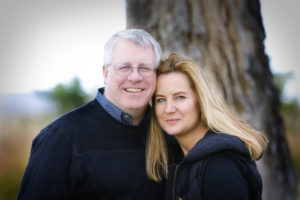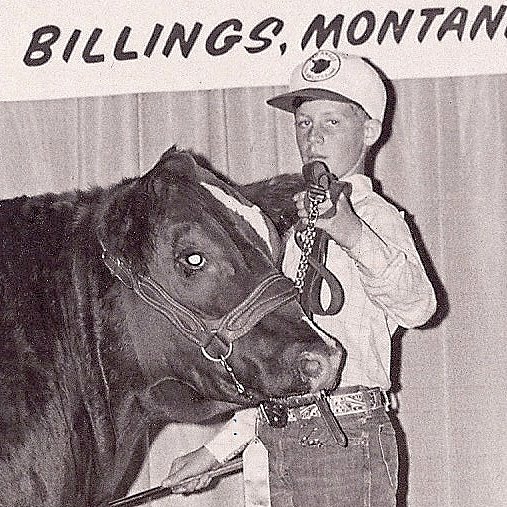 Third-generation seedstock producer Lee Leachman has spent his lifetime breeding and marketing cattle. At the young age of 7, he started helping with heat detection on his family’s 2,300-head operation in Billings, Montana, and through the years he has mastered the marketing and selection of seedstock.
Third-generation seedstock producer Lee Leachman has spent his lifetime breeding and marketing cattle. At the young age of 7, he started helping with heat detection on his family’s 2,300-head operation in Billings, Montana, and through the years he has mastered the marketing and selection of seedstock.
Lee is currently serving as president of the Beef Improvement Federation (BIF), an organization dedicated to coordinating all segments of the beef industry — from researchers and producers to retailers — in an effort to improve the efficiency, profitability and sustainability of beef production.
He is the managing partner of Leachman Cattle of Colorado (LCoC) with headquarters in Fort Collins, Colorado. The organization markets more than 2,000 bulls annually including Angus, Charolais, Red Angus and Stabilizer composites.
The bulls are produced through a network of cooperator producers and via embryo transplant (ET). “Today we have about 45 cooperators that annually breed about 10,000 cows,” Lee says. “The top half of those bull calves are being marketed through us. The balance of those bull calves would go to harvest, and we collect carcass data.”
LCoC provides cooperators with breeding, selection and marketing services. The cooperators own the cows and the land and provide the management to raise the bulls. Most LCoC cooperators have been in the Leachman breeding program for more than a decade.
Early years
Lee’s family moved to Montana when he was 4 years old. He spent his youth helping on the family’s ranch and honing his skills as a cattleman. As high school graduation approached, Lee’s dad, Jim, encouraged him to major in something other than animal science. Lee was accepted to Harvard and studied economics. A few years after college, still hungry for beef production knowledge, he spent a semester at Colorado State University taking animal science classes including animal breeding, reproductive physiology, meat science and microbiology.
Lee then returned to the family operation and got involved in the management of the business — Leachman Cattle Company (LCC). The operation would grow to be one of the world’s largest seedstock operations selling more than 3,000 bulls per year in the early 2000s.
“In 2003, the world fell apart for us,” Lee explains. “My wife and I got separated, my dad and I got in a lawsuit, we lost the business, and I had to move. It was bad. When I talk about it sometimes, I tell people the only thing that didn’t happen is Harvard didn’t call and take my degree away.
 “But it makes you really take stock of where you put your hope. To be truthful, my priorities were way out of whack back then. And it was a good thing to kind of lose all that and to have to take stock and say what’s really important. And today, thanks to God, those relationships are all restored. And that’s the most important part. The fact that the business is what it is, is really just an extra bonus.”
“But it makes you really take stock of where you put your hope. To be truthful, my priorities were way out of whack back then. And it was a good thing to kind of lose all that and to have to take stock and say what’s really important. And today, thanks to God, those relationships are all restored. And that’s the most important part. The fact that the business is what it is, is really just an extra bonus.”
Today, Lee is based out of Fort Collins and spends much of his time traveling and promoting LCoC. Lee and his wife, Lisa, have one son, Graham, who is a junior at Colorado State University majoring in business.
Focused on science
LCoC is committed to using the most advanced breeding and selection tools available to raise cattle that are more profitable. “Shortly after I went to work for Dallas Horton in 2003, we had a meeting one morning, and he was talking about buying bulls out of one of our sales for his cow herd. And I said to him, ‘Well, what traits do you want?’ And he said, I don’t want traits, I want the bulls that are going to make me the most money. Which ones are those?
“And I said, ‘Well, I really can’t answer that.’ And that was really not a very good answer for Dallas. He said, what do you mean you can’t answer that? That’s why we’re doing this. If we can’t tell people how to make more money, what are we doing?”
That conversation lead LCoC to start calculating genetic prediction indexes.
BIF involvement
 “I’ve always been intrigued by the science and how we can breed better cattle,” Lee explains. “My mind thinks numerically, mathematically, statistically, so I like that stuff. I like being challenged on what traits we should be studying, and about what the effects are from selection.”
“I’ve always been intrigued by the science and how we can breed better cattle,” Lee explains. “My mind thinks numerically, mathematically, statistically, so I like that stuff. I like being challenged on what traits we should be studying, and about what the effects are from selection.”
He recognizes the annual BIF Convention and Research Symposium is the best meeting to attend to be able to keep up with what is new in beef cattle genetics. Lee says he chose to run for the BIF board and invest time serving the organization because he loves the people who attend the BIF meetings, the atmosphere and the information exchange. “My interest in BIF is encouraging the research community, breed associations and breeders to proactively and aggressively seek better decision support tools,” he explains.
Lee is a second-generation BIF president — his dad served as BIF president in 1992-93. “I think that one of the challenges that we have today is that the science is so advanced, it’s hard for most of us to really understand how it works,” Lee explains. “As breeders, how do we take that technology and utilize it without making really big mistakes? One of my favorite analogies is, it’s like a race car. You can go really fast, but steering is really important, because otherwise you’ll crash.
“We have a race car now and we can go fast. The challenge is figuring out which way to go. And I think BIF needs to be the place where the direction beef cattle genetics is going is decided.”
Join us in Brookings
Lee will pass the BIF reins to the next president on Thursday, June 20, but there’s no doubt his passion and commitment to BIF’s principles and goals will continue for years to come.
“Lee’s strengths of being a visionary leader and understanding the business side of beef production have been invaluable to BIF,” explains Jane Parish, BIF executive director. “As president, he has advocated for advancing development and utilization of science-based selection tools that incorporate economics along with genetic information. Lee communicates the importance of robust discussions on best uses of selection tools to achieve genetic improvement and profitability goals.”
A complete schedule for this year’s BIF Annual Meeting and Research Symposium is available online at BeefImprovement.org. This year’s symposium features two-and-a-half days of educational programming and a full day of tours. The morning sessions will focus on “Applications of Technology” and “Utilization of Big Data.” The afternoon breakout sessions both days will focus on a range of beef production and genetic improvement topics.
The conference also features a Young Producer Symposium on Tuesday afternoon, designed for networking and to equip young cattle producers with essential knowledge as they grow their role in the business. Tuesday evening attendees will also enjoy an opening reception followed by the National Association of Animal Breeders Symposium at 7 p.m.
“I think if we look back to what’s happened in cattle breeding in the United States over the last 40 to 50 years, BIF has been at the center of almost all of the major shifts,” Lee summarizes. “There’s just been a lot of things that have happened at BIF that shape what we do in beef cattle production. And over time those small changes become big changes. And I think that’s probably what turns my crank more than anything is trying to improve cattle and seeing how that affects the families that raise cattle commercially.”

